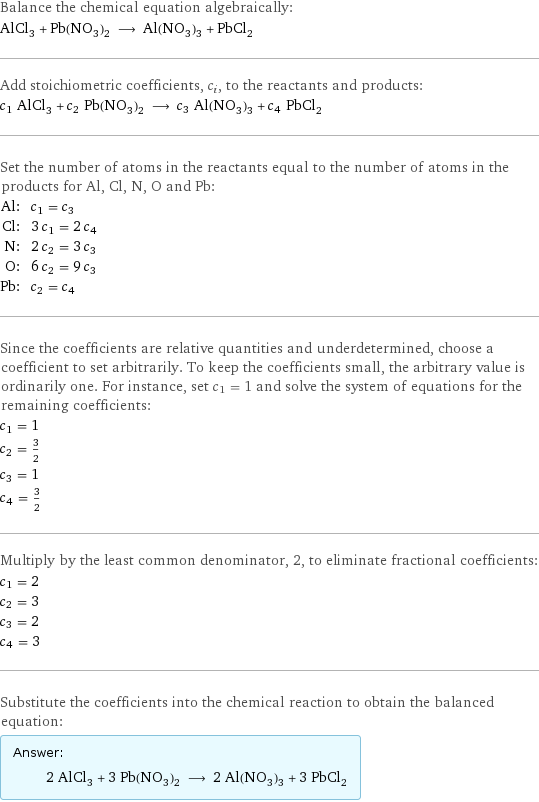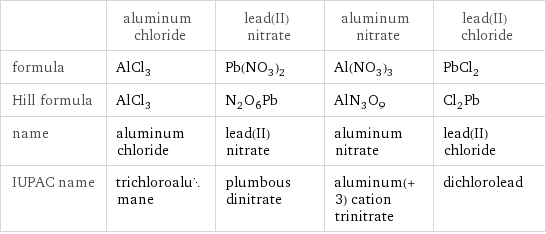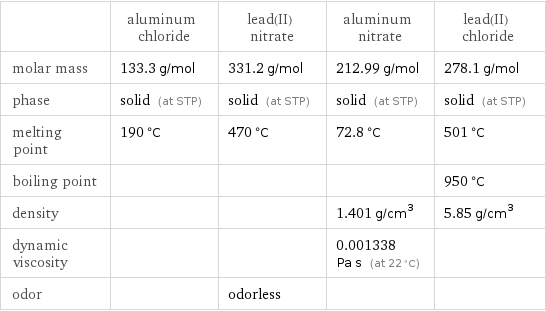Input interpretation

AlCl_3 aluminum chloride + Pb(NO_3)_2 lead(II) nitrate ⟶ Al(NO_3)_3 aluminum nitrate + PbCl_2 lead(II) chloride
Balanced equation

Balance the chemical equation algebraically: AlCl_3 + Pb(NO_3)_2 ⟶ Al(NO_3)_3 + PbCl_2 Add stoichiometric coefficients, c_i, to the reactants and products: c_1 AlCl_3 + c_2 Pb(NO_3)_2 ⟶ c_3 Al(NO_3)_3 + c_4 PbCl_2 Set the number of atoms in the reactants equal to the number of atoms in the products for Al, Cl, N, O and Pb: Al: | c_1 = c_3 Cl: | 3 c_1 = 2 c_4 N: | 2 c_2 = 3 c_3 O: | 6 c_2 = 9 c_3 Pb: | c_2 = c_4 Since the coefficients are relative quantities and underdetermined, choose a coefficient to set arbitrarily. To keep the coefficients small, the arbitrary value is ordinarily one. For instance, set c_1 = 1 and solve the system of equations for the remaining coefficients: c_1 = 1 c_2 = 3/2 c_3 = 1 c_4 = 3/2 Multiply by the least common denominator, 2, to eliminate fractional coefficients: c_1 = 2 c_2 = 3 c_3 = 2 c_4 = 3 Substitute the coefficients into the chemical reaction to obtain the balanced equation: Answer: | | 2 AlCl_3 + 3 Pb(NO_3)_2 ⟶ 2 Al(NO_3)_3 + 3 PbCl_2
Structures

+ ⟶ +
Names

aluminum chloride + lead(II) nitrate ⟶ aluminum nitrate + lead(II) chloride
Equilibrium constant
![Construct the equilibrium constant, K, expression for: AlCl_3 + Pb(NO_3)_2 ⟶ Al(NO_3)_3 + PbCl_2 Plan: • Balance the chemical equation. • Determine the stoichiometric numbers. • Assemble the activity expression for each chemical species. • Use the activity expressions to build the equilibrium constant expression. Write the balanced chemical equation: 2 AlCl_3 + 3 Pb(NO_3)_2 ⟶ 2 Al(NO_3)_3 + 3 PbCl_2 Assign stoichiometric numbers, ν_i, using the stoichiometric coefficients, c_i, from the balanced chemical equation in the following manner: ν_i = -c_i for reactants and ν_i = c_i for products: chemical species | c_i | ν_i AlCl_3 | 2 | -2 Pb(NO_3)_2 | 3 | -3 Al(NO_3)_3 | 2 | 2 PbCl_2 | 3 | 3 Assemble the activity expressions accounting for the state of matter and ν_i: chemical species | c_i | ν_i | activity expression AlCl_3 | 2 | -2 | ([AlCl3])^(-2) Pb(NO_3)_2 | 3 | -3 | ([Pb(NO3)2])^(-3) Al(NO_3)_3 | 2 | 2 | ([Al(NO3)3])^2 PbCl_2 | 3 | 3 | ([PbCl2])^3 The equilibrium constant symbol in the concentration basis is: K_c Mulitply the activity expressions to arrive at the K_c expression: Answer: | | K_c = ([AlCl3])^(-2) ([Pb(NO3)2])^(-3) ([Al(NO3)3])^2 ([PbCl2])^3 = (([Al(NO3)3])^2 ([PbCl2])^3)/(([AlCl3])^2 ([Pb(NO3)2])^3)](../image_source/e21b9b1db3a10fa818705cb0402a0fc1.png)
Construct the equilibrium constant, K, expression for: AlCl_3 + Pb(NO_3)_2 ⟶ Al(NO_3)_3 + PbCl_2 Plan: • Balance the chemical equation. • Determine the stoichiometric numbers. • Assemble the activity expression for each chemical species. • Use the activity expressions to build the equilibrium constant expression. Write the balanced chemical equation: 2 AlCl_3 + 3 Pb(NO_3)_2 ⟶ 2 Al(NO_3)_3 + 3 PbCl_2 Assign stoichiometric numbers, ν_i, using the stoichiometric coefficients, c_i, from the balanced chemical equation in the following manner: ν_i = -c_i for reactants and ν_i = c_i for products: chemical species | c_i | ν_i AlCl_3 | 2 | -2 Pb(NO_3)_2 | 3 | -3 Al(NO_3)_3 | 2 | 2 PbCl_2 | 3 | 3 Assemble the activity expressions accounting for the state of matter and ν_i: chemical species | c_i | ν_i | activity expression AlCl_3 | 2 | -2 | ([AlCl3])^(-2) Pb(NO_3)_2 | 3 | -3 | ([Pb(NO3)2])^(-3) Al(NO_3)_3 | 2 | 2 | ([Al(NO3)3])^2 PbCl_2 | 3 | 3 | ([PbCl2])^3 The equilibrium constant symbol in the concentration basis is: K_c Mulitply the activity expressions to arrive at the K_c expression: Answer: | | K_c = ([AlCl3])^(-2) ([Pb(NO3)2])^(-3) ([Al(NO3)3])^2 ([PbCl2])^3 = (([Al(NO3)3])^2 ([PbCl2])^3)/(([AlCl3])^2 ([Pb(NO3)2])^3)
Rate of reaction
![Construct the rate of reaction expression for: AlCl_3 + Pb(NO_3)_2 ⟶ Al(NO_3)_3 + PbCl_2 Plan: • Balance the chemical equation. • Determine the stoichiometric numbers. • Assemble the rate term for each chemical species. • Write the rate of reaction expression. Write the balanced chemical equation: 2 AlCl_3 + 3 Pb(NO_3)_2 ⟶ 2 Al(NO_3)_3 + 3 PbCl_2 Assign stoichiometric numbers, ν_i, using the stoichiometric coefficients, c_i, from the balanced chemical equation in the following manner: ν_i = -c_i for reactants and ν_i = c_i for products: chemical species | c_i | ν_i AlCl_3 | 2 | -2 Pb(NO_3)_2 | 3 | -3 Al(NO_3)_3 | 2 | 2 PbCl_2 | 3 | 3 The rate term for each chemical species, B_i, is 1/ν_i(Δ[B_i])/(Δt) where [B_i] is the amount concentration and t is time: chemical species | c_i | ν_i | rate term AlCl_3 | 2 | -2 | -1/2 (Δ[AlCl3])/(Δt) Pb(NO_3)_2 | 3 | -3 | -1/3 (Δ[Pb(NO3)2])/(Δt) Al(NO_3)_3 | 2 | 2 | 1/2 (Δ[Al(NO3)3])/(Δt) PbCl_2 | 3 | 3 | 1/3 (Δ[PbCl2])/(Δt) (for infinitesimal rate of change, replace Δ with d) Set the rate terms equal to each other to arrive at the rate expression: Answer: | | rate = -1/2 (Δ[AlCl3])/(Δt) = -1/3 (Δ[Pb(NO3)2])/(Δt) = 1/2 (Δ[Al(NO3)3])/(Δt) = 1/3 (Δ[PbCl2])/(Δt) (assuming constant volume and no accumulation of intermediates or side products)](../image_source/3bb328969a502debe5f9011d0531bb4b.png)
Construct the rate of reaction expression for: AlCl_3 + Pb(NO_3)_2 ⟶ Al(NO_3)_3 + PbCl_2 Plan: • Balance the chemical equation. • Determine the stoichiometric numbers. • Assemble the rate term for each chemical species. • Write the rate of reaction expression. Write the balanced chemical equation: 2 AlCl_3 + 3 Pb(NO_3)_2 ⟶ 2 Al(NO_3)_3 + 3 PbCl_2 Assign stoichiometric numbers, ν_i, using the stoichiometric coefficients, c_i, from the balanced chemical equation in the following manner: ν_i = -c_i for reactants and ν_i = c_i for products: chemical species | c_i | ν_i AlCl_3 | 2 | -2 Pb(NO_3)_2 | 3 | -3 Al(NO_3)_3 | 2 | 2 PbCl_2 | 3 | 3 The rate term for each chemical species, B_i, is 1/ν_i(Δ[B_i])/(Δt) where [B_i] is the amount concentration and t is time: chemical species | c_i | ν_i | rate term AlCl_3 | 2 | -2 | -1/2 (Δ[AlCl3])/(Δt) Pb(NO_3)_2 | 3 | -3 | -1/3 (Δ[Pb(NO3)2])/(Δt) Al(NO_3)_3 | 2 | 2 | 1/2 (Δ[Al(NO3)3])/(Δt) PbCl_2 | 3 | 3 | 1/3 (Δ[PbCl2])/(Δt) (for infinitesimal rate of change, replace Δ with d) Set the rate terms equal to each other to arrive at the rate expression: Answer: | | rate = -1/2 (Δ[AlCl3])/(Δt) = -1/3 (Δ[Pb(NO3)2])/(Δt) = 1/2 (Δ[Al(NO3)3])/(Δt) = 1/3 (Δ[PbCl2])/(Δt) (assuming constant volume and no accumulation of intermediates or side products)
Chemical names and formulas

| aluminum chloride | lead(II) nitrate | aluminum nitrate | lead(II) chloride formula | AlCl_3 | Pb(NO_3)_2 | Al(NO_3)_3 | PbCl_2 Hill formula | AlCl_3 | N_2O_6Pb | AlN_3O_9 | Cl_2Pb name | aluminum chloride | lead(II) nitrate | aluminum nitrate | lead(II) chloride IUPAC name | trichloroalumane | plumbous dinitrate | aluminum(+3) cation trinitrate | dichlorolead
Substance properties

| aluminum chloride | lead(II) nitrate | aluminum nitrate | lead(II) chloride molar mass | 133.3 g/mol | 331.2 g/mol | 212.99 g/mol | 278.1 g/mol phase | solid (at STP) | solid (at STP) | solid (at STP) | solid (at STP) melting point | 190 °C | 470 °C | 72.8 °C | 501 °C boiling point | | | | 950 °C density | | | 1.401 g/cm^3 | 5.85 g/cm^3 dynamic viscosity | | | 0.001338 Pa s (at 22 °C) | odor | | odorless | |
Units
